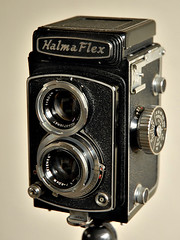Difference between revisions of "Halma 6×6 TLR"
Hanskerensky (talk | contribs) (→Links: <!--Removed link, page no longer present, unlikely that it returns -->) |
Hanskerensky (talk | contribs) m (→The Prinz Flex and Prinz Auto: Repaired Image URL) |
||
| (8 intermediate revisions by the same user not shown) | |||
| Line 23: | Line 23: | ||
{| class="plainlinks floatright" width=240px style="text-align: center;" | {| class="plainlinks floatright" width=240px style="text-align: center;" | ||
|- | |- | ||
| − | || [http://www.flickr.com/photos/ | + | || [http://www.flickr.com/photos/camerawiki/45882389855/in/pool-camerawiki/ http://farm5.staticflickr.com/4891/45882389855_d36c272af6_m_d.jpg] |
|- | |- | ||
|| ''Halma Flex IB no.31802, type 1 nameplate, Halmar Anastigmat and View Halmar 8cm f/3.5 lenses. Picture by Terry Calvert. {{with permission}}'' | || ''Halma Flex IB no.31802, type 1 nameplate, Halmar Anastigmat and View Halmar 8cm f/3.5 lenses. Picture by Terry Calvert. {{with permission}}'' | ||
| Line 30: | Line 30: | ||
Type 1 nameplate has been observed on a few cameras only. They have an accessory shoe on the photographer's right. The strap lugs are identical to those of the last [[Lustreflex]] models. The focus knob is surrounded by a silver depth-of-field scale. The taking lens is a Halmar Anastigmat 8cm f/3.5 and the viewing lens is a View Halmar 8cm f/3.2 of slightly larger aperture. | Type 1 nameplate has been observed on a few cameras only. They have an accessory shoe on the photographer's right. The strap lugs are identical to those of the last [[Lustreflex]] models. The focus knob is surrounded by a silver depth-of-field scale. The taking lens is a Halmar Anastigmat 8cm f/3.5 and the viewing lens is a View Halmar 8cm f/3.2 of slightly larger aperture. | ||
| − | One example has serial no.31234 and corresponds to the specifications for the Halma Flex I; it has a simple shutter casing with a black front plate.<REF> Example pictured in [http://www.chinesecamera.net/thread-23971-1-1.html this page at www.chinesecamera.net]. </REF> That pictured on the right has serial no.31802 and corresponds to a Halma Flex IB; its shutter casing is similar but has a silver front plate. Further cameras correspond to the Halma Flex IIB.<REF> Examples pictured in {{MK}}, p.376, and observed in an online auction. </REF> | + | One example has serial no.31234 and corresponds to the specifications for the Halma Flex I; it has a simple shutter casing with a black front plate.<REF> Example pictured in [https://web.archive.org/web/20080121053656/http://www.chinesecamera.net/thread-23971-1-1.html this page at www.chinesecamera.net] (archived). </REF> That pictured on the right has serial no.31802 and corresponds to a Halma Flex IB; its shutter casing is similar but has a silver front plate. Further cameras correspond to the Halma Flex IIB.<REF> Examples pictured in {{MK}}, p.376, and observed in an online auction. </REF> |
=== Type 2 nameplate === | === Type 2 nameplate === | ||
{| class="plainlinks" style="margin: 0 auto; text-align: center;" | {| class="plainlinks" style="margin: 0 auto; text-align: center;" | ||
|- | |- | ||
| − | || [http://www.flickr.com/photos/ | + | || [http://www.flickr.com/photos/camerawiki/46797554561/in/pool-camerawiki/ http://farm8.staticflickr.com/7879/46797554561_bec8665638_d.jpg] |
|- | |- | ||
|| ''Halma Flex no.43160, type 2 nameplate, [[Copal-MXV]] shutter, Halmar and Viewer Halmar 75mm f/3.5 lenses.<br />Picture by Keith Rock. {{with permission}}'' | || ''Halma Flex no.43160, type 2 nameplate, [[Copal-MXV]] shutter, Halmar and Viewer Halmar 75mm f/3.5 lenses.<br />Picture by Keith Rock. {{with permission}}'' | ||
| Line 42: | Line 42: | ||
Most of the Halma Flex cameras have type 2 nameplate and a serial number in the 4xxxx range. The accessory shoe, strap lugs and depth-of-field scale are similar to those fitting earlier examples. | Most of the Halma Flex cameras have type 2 nameplate and a serial number in the 4xxxx range. The accessory shoe, strap lugs and depth-of-field scale are similar to those fitting earlier examples. | ||
| − | The manual examples have a round red window in the back, protected by a vertically sliding cover. Examples of the model I have a black shutter plate; at least one of them is known with gray leatherette covering.<REF> Black covering: example pictured in {{MK}}, p.376. Gray covering: example pictured in [http://www.lomo.us/forums/showthread.php?s=&threadid=4225 this Lomo.us forum post], body no.44906. </REF> | + | The manual examples have a round red window in the back, protected by a vertically sliding cover. Examples of the model I have a black shutter plate; at least one of them is known with gray leatherette covering.<REF> Black covering: example pictured in {{MK}}, p.376. Gray covering: example pictured in [https://web.archive.org/web/20080516151518/http://www.lomo.us/forums/showthread.php?s=&threadid=4225 this Lomo.us forum post] (archived), body no.44906. </REF> |
The semi-automatic examples have a round exposure counter window above the accessory shoe, and no red window in the back. The position of the first exposure is certainly set by aligning the start mark of the leader paper with a mark inside the body. Some examples may have the same simple shutter casing as on earlier cameras, with a silver front plate. Others, such as that pictured above, have a [[Copal-MXV]] shutter under a more elaborate black casing.<REF> Examples pictured in this page, in [http://www.tlr-cameras.com/Japanese/slides/Halma%20Flex.html this page at tlr-cameras.com], and observed in an online auction. </REF> The Halmar Anastigmat and View Halmar lenses were replaced at some time by Halmar and Viewer Halmar 75mm f/3.5, as is visible on the above camera. | The semi-automatic examples have a round exposure counter window above the accessory shoe, and no red window in the back. The position of the first exposure is certainly set by aligning the start mark of the leader paper with a mark inside the body. Some examples may have the same simple shutter casing as on earlier cameras, with a silver front plate. Others, such as that pictured above, have a [[Copal-MXV]] shutter under a more elaborate black casing.<REF> Examples pictured in this page, in [http://www.tlr-cameras.com/Japanese/slides/Halma%20Flex.html this page at tlr-cameras.com], and observed in an online auction. </REF> The Halmar Anastigmat and View Halmar lenses were replaced at some time by Halmar and Viewer Halmar 75mm f/3.5, as is visible on the above camera. | ||
| Line 59: | Line 59: | ||
{| class="plainlinks" align=center style="text-align: center;" | {| class="plainlinks" align=center style="text-align: center;" | ||
|- | |- | ||
| − | || [http://www.flickr.com/photos/alvaropics/1032033980/in/pool-camerawiki http://farm2.static.flickr.com/1358/1032033980_1cf2154eb9.jpg] [http://www.flickr.com/photos/alvaropics/1162037219/in/pool-camerawiki http:// | + | || [http://www.flickr.com/photos/alvaropics/1032033980/in/pool-camerawiki http://farm2.static.flickr.com/1358/1032033980_1cf2154eb9.jpg] [http://www.flickr.com/photos/alvaropics/1162037219/in/pool-camerawiki http://farm8.staticflickr.com/7904/46797610381_46f6fa2bba_m.jpg] |
|- | |- | ||
|| ''Prinz Auto no.2606, Tri-Lausar Anastigmat 8cm f/3.5 taking lens no.23332, Tri-Lausar Viewer 8cm f/3.5 viewing lens no.23398.''<br />''Pictures by [http://www.flickr.com/photos/alvaropics/ Alvaro Munoz-Aycuens Mtnz.] {{with permission}}'' | || ''Prinz Auto no.2606, Tri-Lausar Anastigmat 8cm f/3.5 taking lens no.23332, Tri-Lausar Viewer 8cm f/3.5 viewing lens no.23398.''<br />''Pictures by [http://www.flickr.com/photos/alvaropics/ Alvaro Munoz-Aycuens Mtnz.] {{with permission}}'' | ||
| Line 65: | Line 65: | ||
{| class="plainlinks floatright" style="text-align: center;" | {| class="plainlinks floatright" style="text-align: center;" | ||
|- | |- | ||
| − | | width=250px | [http://www.flickr.com/photos/ | + | | width=250px | [http://www.flickr.com/photos/camerawiki/46797583321/in/pool-camerawiki/ http://farm8.staticflickr.com/7914/46797583321_a1c0650521_m_d.jpg] |
| − | | width=200px | [http://www.flickr.com/photos/ | + | | width=200px | [http://www.flickr.com/photos/camerawiki/46797610381/in/pool-camerawiki/ https://live.staticflickr.com/7904/46797610381_46f6fa2bba_m_d.jpg] |
|- | |- | ||
|| ''Prinz Flex no.2567.<br />Picture courtesy of eBayer camcentre. {{with permission}}'' | || ''Prinz Flex no.2567.<br />Picture courtesy of eBayer camcentre. {{with permission}}'' | ||
| Line 73: | Line 73: | ||
The Prinz Flex and Prinz Auto were distributed by the British company [[Dixons]] around 1960.<REF> Terry Scott reports in [http://photo.net/bboard/q-and-a-fetch-msg?msg_id=00C0Mo this thread at photo.net] that he bought a Prinz Auto new in the 1960s. </REF> | The Prinz Flex and Prinz Auto were distributed by the British company [[Dixons]] around 1960.<REF> Terry Scott reports in [http://photo.net/bboard/q-and-a-fetch-msg?msg_id=00C0Mo this thread at photo.net] that he bought a Prinz Auto new in the 1960s. </REF> | ||
| − | The '''Prinz Flex''' is a name variant of the Halma Flex I. The nameplate reads ''PRINZ FLEX'' and has a four-digit serial number inscribed in small characters above. All the examples observed so far have grey leatherette covering; except for the nameplate, they are similar to the grey Halma Flex I (type 2) described above.<REF> Examples pictured in [http://www.tlr-cameras.com/Japanese/slides/Prinz%20Flex.html this page at tlr-cameras.com], in [http://www.bonhams.com/ | + | The '''Prinz Flex''' is a name variant of the Halma Flex I. The nameplate reads ''PRINZ FLEX'' and has a four-digit serial number inscribed in small characters above. All the examples observed so far have grey leatherette covering; except for the nameplate, they are similar to the grey Halma Flex I (type 2) described above.<REF> Examples pictured in [http://www.tlr-cameras.com/Japanese/slides/Prinz%20Flex.html this page at tlr-cameras.com], in [http://www.bonhams.com/auctions/15198/lot/377/ this page at Bonhams], and observed for sale in online auctions and dealer websites. </REF> They have Halmar Anastigmat and View Halmar lenses. The body edges and the nameplate are painted in a dark grey colour, but the borders of the front standard and viewing hood are black. The focus knob is engraved in metres (in red) and feet (in black). |
The '''Prinz Auto''' is a name variant of the Halma Flex IIB (type 2) with [[Copal-MXV]] shutter. It normally has a Tri-Lausar Anastigmat taking lens and a Tri-Lausar Viewer viewing lens, supplied by [[Tomioka]], but it is said that the Prinz Auto was also advertised with Halmar lenses.<REF> Advertised with Halmar lenses: {{MK}}, p.803. </REF> There are some minor differences from the Halma Flex with Copal: the synch post is placed at the top of the front standard, the M/X selector (with a yellow dot) is not placed the same, the aperture scale has red numbers and runs in the reverse direction (with ''3.5'' at the bottom). The name ''PRINZ AUTO'' is inscribed on a stepped nameplate, with the four-digit serial number engraved in small characters above. The right hand strap lug is engraved ''<small>JAPAN</small>'' and the accessory shoe is engraved ''H.S'', probably for <U>H</U>ara <U>S</U>eisakusho. | The '''Prinz Auto''' is a name variant of the Halma Flex IIB (type 2) with [[Copal-MXV]] shutter. It normally has a Tri-Lausar Anastigmat taking lens and a Tri-Lausar Viewer viewing lens, supplied by [[Tomioka]], but it is said that the Prinz Auto was also advertised with Halmar lenses.<REF> Advertised with Halmar lenses: {{MK}}, p.803. </REF> There are some minor differences from the Halma Flex with Copal: the synch post is placed at the top of the front standard, the M/X selector (with a yellow dot) is not placed the same, the aperture scale has red numbers and runs in the reverse direction (with ''3.5'' at the bottom). The name ''PRINZ AUTO'' is inscribed on a stepped nameplate, with the four-digit serial number engraved in small characters above. The right hand strap lug is engraved ''<small>JAPAN</small>'' and the accessory shoe is engraved ''H.S'', probably for <U>H</U>ara <U>S</U>eisakusho. | ||
| Line 110: | Line 110: | ||
[[Category: Japanese 6x6 TLR]] | [[Category: Japanese 6x6 TLR]] | ||
[[Category: H]] | [[Category: H]] | ||
| + | [[Category:120 film]] | ||
Latest revision as of 05:33, 19 September 2022
The Halma Flex and Halma Auto are Japanese 6×6 TLR cameras, perhaps made around 1960 by a company called Hara, successor of Lustre.[1] The Prinz Flex and Prinz Auto are name variants of the Halma Flex.
Contents
Common features
The Halma Flex and its Prinz name variants are regular copies of the Rolleicord. The front plate moves back and forth for focusing. The film advance knob is on the photographer's right and the focus knob is on the left. The release button is placed at the bottom of the front standard, on the photographer's right, and the synch post is buried in the front plate on the opposite side. It seems that all the models have a sportsfinder in the viewing hood and an accessory shoe. The Halma Auto has similar features with a crank advance.
Advertised versions
The only advertisement for the Halma 6×6 TLR observed so far was published in Camerart (a Japanese magazine published in English language), perhaps in 1960.[2] It was inserted by Tohko Co., Ltd., certainly the distributor of the camera, and also presents the Halma 44 and the Owla Stereo. Four versions of the Halma Flex are listed, all of them having a synchronized shutter of the "Prontor type" (B, 1–300, self-timer):
- Halma Flex I: red window film advance, push-on filters;
- Halma Flex IB: red window film advance, bayonet filters;
- Halma Flex II: semi-automatic film advance, push-on filters;
- Halma Flex IIB: semi-automatic film advance, bayonet filters.
The description says that the exposure counter of the semi-automatic models is automatically reset to "S" when the back is opened.
Evolution of the Halma Flex
The Halma Flex is known with three types of nameplate, all of them inscribed HalmaFlex. Type 1 is oval and has a small serial number, type 2 is almost rectangular and has a serial number too, type 3 is almost oval and has no serial number.
Today, the Halma Flex is surprisingly common in South American online auctions, from Argentina or Brazil; this is perhaps an indication that the camera was exported to these two countries. (A transaction for a Halma Auto has been recorded in Argentina too.)
Type 1 nameplate
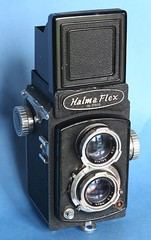
|
| Halma Flex IB no.31802, type 1 nameplate, Halmar Anastigmat and View Halmar 8cm f/3.5 lenses. Picture by Terry Calvert. (Image rights) |
Type 1 nameplate has been observed on a few cameras only. They have an accessory shoe on the photographer's right. The strap lugs are identical to those of the last Lustreflex models. The focus knob is surrounded by a silver depth-of-field scale. The taking lens is a Halmar Anastigmat 8cm f/3.5 and the viewing lens is a View Halmar 8cm f/3.2 of slightly larger aperture.
One example has serial no.31234 and corresponds to the specifications for the Halma Flex I; it has a simple shutter casing with a black front plate.[3] That pictured on the right has serial no.31802 and corresponds to a Halma Flex IB; its shutter casing is similar but has a silver front plate. Further cameras correspond to the Halma Flex IIB.[4]
Type 2 nameplate
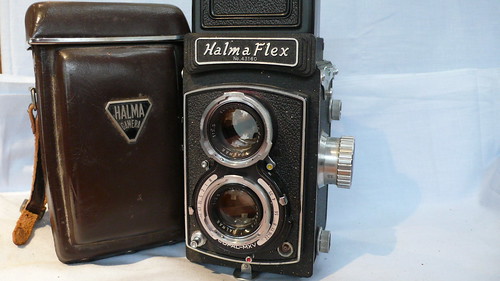
|
| Halma Flex no.43160, type 2 nameplate, Copal-MXV shutter, Halmar and Viewer Halmar 75mm f/3.5 lenses. Picture by Keith Rock. (Image rights) |
Most of the Halma Flex cameras have type 2 nameplate and a serial number in the 4xxxx range. The accessory shoe, strap lugs and depth-of-field scale are similar to those fitting earlier examples.
The manual examples have a round red window in the back, protected by a vertically sliding cover. Examples of the model I have a black shutter plate; at least one of them is known with gray leatherette covering.[5]
The semi-automatic examples have a round exposure counter window above the accessory shoe, and no red window in the back. The position of the first exposure is certainly set by aligning the start mark of the leader paper with a mark inside the body. Some examples may have the same simple shutter casing as on earlier cameras, with a silver front plate. Others, such as that pictured above, have a Copal-MXV shutter under a more elaborate black casing.[6] The Halmar Anastigmat and View Halmar lenses were replaced at some time by Halmar and Viewer Halmar 75mm f/3.5, as is visible on the above camera.
Type 3 nameplate

|
| Halma Flex, type 3 nameplate. The taking and viewing lenses are swapped. Picture by NicoZ. (Image rights) |
Later examples have type 3 nameplate. They are similar to the camera pictured in the 1960 advertisement, and many minor features differ from the previous examples. There are new shorter strap lugs, a different back latch engraved JAPAN, and a different focus knob with a film reminder and a black depth-of-field scale. The accessory shoe has moved to a new location above the focus knob. The shutter release is bigger and contains a cable release thread. It seems that the camera now has 8.0cm f/3.5 lenses, and at least one source reports a pair of Tri-Lausar by Tomioka.[7]
The Prinz Flex and Prinz Auto
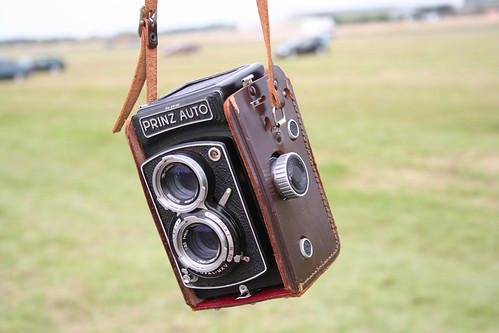 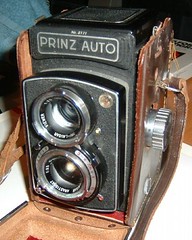
|
| Prinz Auto no.2606, Tri-Lausar Anastigmat 8cm f/3.5 taking lens no.23332, Tri-Lausar Viewer 8cm f/3.5 viewing lens no.23398. Pictures by Alvaro Munoz-Aycuens Mtnz. (Image rights) |
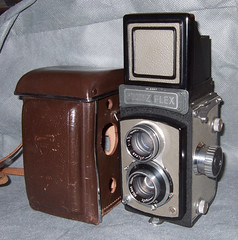
|

|
| Prinz Flex no.2567. Picture courtesy of eBayer camcentre. (Image rights) |
Prinz Auto no.3171. Picture courtesy of Glyn Coburn-Gee. (Image rights) |
The Prinz Flex and Prinz Auto were distributed by the British company Dixons around 1960.[8]
The Prinz Flex is a name variant of the Halma Flex I. The nameplate reads PRINZ FLEX and has a four-digit serial number inscribed in small characters above. All the examples observed so far have grey leatherette covering; except for the nameplate, they are similar to the grey Halma Flex I (type 2) described above.[9] They have Halmar Anastigmat and View Halmar lenses. The body edges and the nameplate are painted in a dark grey colour, but the borders of the front standard and viewing hood are black. The focus knob is engraved in metres (in red) and feet (in black).
The Prinz Auto is a name variant of the Halma Flex IIB (type 2) with Copal-MXV shutter. It normally has a Tri-Lausar Anastigmat taking lens and a Tri-Lausar Viewer viewing lens, supplied by Tomioka, but it is said that the Prinz Auto was also advertised with Halmar lenses.[10] There are some minor differences from the Halma Flex with Copal: the synch post is placed at the top of the front standard, the M/X selector (with a yellow dot) is not placed the same, the aperture scale has red numbers and runs in the reverse direction (with 3.5 at the bottom). The name PRINZ AUTO is inscribed on a stepped nameplate, with the four-digit serial number engraved in small characters above. The right hand strap lug is engraved JAPAN and the accessory shoe is engraved H.S, probably for Hara Seisakusho.
The Prinz Flex and Prinz Auto probably shared a common sequence of serial numbers; those confirmed so far range from 1938 to 3171.[11] The ever-ready case for both cameras is similar except for the cut-out at the rear for the red window. It is made of brown leather and has a triangular PRINZ logo.
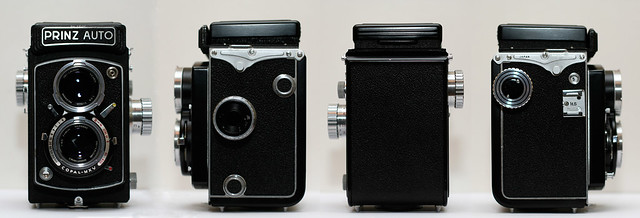
|
| More photos of Prinz Auto no.2606 image by Alvaro Munoz-Aycuens Mtnz. (Image rights) |
The Halma Auto
The Halma Auto is a crank advance version of the Halma Flex IIB. It was listed in the 1960 advertisement cited above,[2] where the film advance is described as "fully automatic". It is not known if this corresponds to automatic film loading as on a Rolleiflex, or simply to the faster crank advance, which cocks the shutter at the same time. The advertisement also mentions the ability to make double exposures when required.
The Halma Auto is only known with the type 3 nameplate and the newer strap lugs and back latch, whether in the advertising picture or in the only other picture observed so far.[12] The position of the exposure counter window is higher than on the regular Halma Flex, this feature is perhaps shared with the other "type 3" Halma Flex.
Notes
- ↑ Attribution to Hara: message by Koji Namikawa in this page at tlr-cameras.com, based on documents about the camera inspections for export.
- ↑ 2.0 2.1 Advertisement reproduced in this page at tlr-cameras.com.
- ↑ Example pictured in this page at www.chinesecamera.net (archived).
- ↑ Examples pictured in McKeown, p.376, and observed in an online auction.
- ↑ Black covering: example pictured in McKeown, p.376. Gray covering: example pictured in this Lomo.us forum post (archived), body no.44906.
- ↑ Examples pictured in this page, in this page at tlr-cameras.com, and observed in an online auction.
- ↑ Tri-Lausar lenses reported in an online auction. The camera pictured in this page has unspecified 8.0cm f/3.5 lenses. The taking and viewing lenses have been swapped, probably the result of a bad repair.
- ↑ Terry Scott reports in this thread at photo.net that he bought a Prinz Auto new in the 1960s.
- ↑ Examples pictured in this page at tlr-cameras.com, in this page at Bonhams, and observed for sale in online auctions and dealer websites.
- ↑ Advertised with Halmar lenses: McKeown, p.803.
- ↑ Example observed in an online auction.
- ↑ Example pictured in this page at tlr-cameras.com.
Bibliography
- McKeown, James M. and Joan C. McKeown's Price Guide to Antique and Classic Cameras, 12th Edition, 2005-2006. USA, Centennial Photo Service, 2004. ISBN 0-931838-40-1 (hardcover). ISBN 0-931838-41-X (softcover). Pp.376 and 803.
The Halma Flex, Halma Auto, Prinz Flex and Prinz Auto are not listed in Sugiyama or in Kokusan kamera no rekishi.
Links
In English:
- Pages at tlr-cameras.com:
- Other Japanese 120 (6×6) TLRs, with a Halma Flex, a Prinz Flex and a Prinz Auto
- Halma advertisement
- Prinz Flex, lot no.377 of Bonhams auction no.6610 (3 July 1997)
- TLR album among Alvaro's Pics at Flickr, with pictures of a Prinz Auto: [1], [2], [3]
- Prinz Auto pictures: [4] and [5] in Chrismehigan's gallery at Flickr
